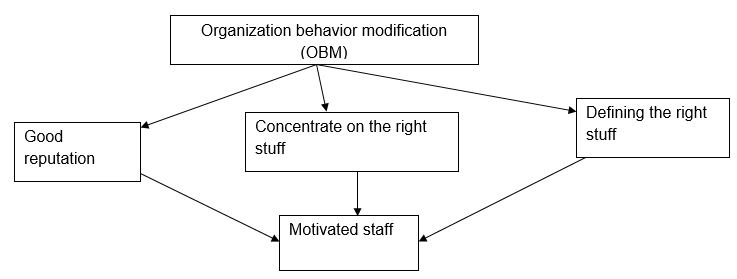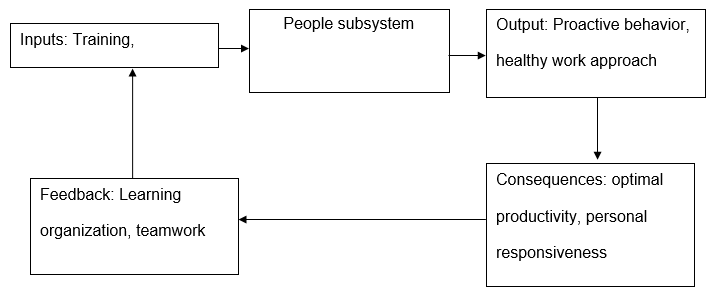Proposed group and team concepts
To successfully create an organization behavior modification plan, it is imperative to review the good reputation, concentrate on the ‘right stuff’, and defining the ‘stuff’. Under defining the ‘stuff’ module, it is important to balance the performance of the employees with the effort they place in the technical elements of sales activities (Aamir, 2008). Under reputation building, the plan should review the problem-solving skills that motivate and create invaluable assets out of employees. This is summarized in the diagram below.

Measuring the key performance behaviors
Employee response
The HRM department at Woody Veneer may use the employee response rate to the changes proposed to measure their perception against company goals (Britt and Jex, 2008). Through employee response, it is possible to focus on the future performance of the company.
Informing the employees of the new standards
Live meetings
The HRM may organize live meetings to inform the employees of the new performance standards. The delivery method for communicating the change message will be face to face meeting since the message requires proactive participation among the employees (Aamir, 2008). The success measurement parameters for the communication plan include managers’ ability to convince the stakeholders on the unanimously favored change.
Organization notice board or website
Despite communication being rated as a high corporate strategy, action planning of the communication method is of the essence to create a solution-oriented task and strategy implementation secession. Thus, the HRM department may communicate the changes in the company’s notice board or website for the employees to view them at their own time (Britt and Jex, 2008).
A plan for providing feedback
360-degree feedback
The 360-degree feedback system management system may influence positive or negative perceptions among employees. Thus, in reviewing performance based on feedback received, the human resource management team at the company should handle any voluntary information with care to boost the trust and confidentiality of the employees who form the pinnacle of organizational behavior. Therefore, it is critical to balance the feedback with the efficiency goals as a remedy towards inclusiveness and active participation, which translates into desirable performance (Britt and Jex, 2008).
Through the 360 degrees feedback, commonly referred to as the multi-source assessment, the HRM personnel will be in a position to manage the behavior feedback channels when appraising performance to ensure that the employees fully support the appraisals. The 360-degree feedback is critical in facilitating the improvement of the performance of employees. When properly implemented, the 360-degree feedback will substantially improve staff productivity, decrease grievances, increase retention, and standardize performance measurement and evaluation. The evaluation can be done after every two months (Aamir, 2008).
Focus performance management
Through focus performance management, the HRM personnel will be in a position to create clear goals on performance appraisal, manage a positive feedback channel, and offer continuous and systematic coaching to ensure that employees perform at optimal productivity level. Thus, the best way to motivate the employees is by giving them responsibilities for achieving something and the authority to do it in their way (Britt and Jex, 2008). Through this approach, employees will be empowered and they will feel trusted and valued by the management personnel and the company. The feedback can be provided after every two months.
Reinforcing positive employee behavior
Leadership theories and application
Positive reinforcement theory
Leadership qualities evoke a modification of behavior in other people. It produces a positive reinforcement to people’s ideas and performance. It occurs due to the positive effects of leadership. It provides a suitable stimulus to evoke the best performances of people (Aamir, 2008). With references to the Woody Veneer Company, positive reinforcement may be applied as indicated below.

Contingency Theory
The Fiedler contingency model describes a leader’s ability based on contingency of the situation. There are two kinds of leaders according to this theory. The first are those that develop a good relationship with their people to deliver a task. The second are those that are only oriented towards the task at hand. They make the accomplishment of the task as their primary aim and take all the steps towards the achievement of this goal (Aamir, 2008). With references to the Woody Veneer Company, positive reinforcement may be applied as indicated below.

References
Aamir, C. (2008). Impact of job involvement on ‘In-Role performance’ and organizational citizenship behavior. Journal of behavior and applied management, 9 (2), 3-8.
Britt, W., & Jex, M. (2008). Organizational Psychology: A Scientist-Practitioner approach. New York, NY: Wiley and Sons.